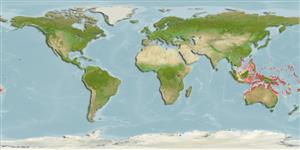>
Acanthuriformes (Surgeonfishes) >
Siganidae (Rabbitfishes)
Etymology: Siganus: Latin, siganus = a fish, rabbit fish; by the similarity of the nose (Ref. 45335).
Issue
Cuvier in Guérin-Méneville, circa 1830.
Environment: milieu / climate zone / depth range / distribution range
Ökologie
seewasser riff-verbunden; tiefenbereich 0 - 15 m (Ref. 90102). Tropical; 20°N - 29°S, 102°E - 174°W
Western Pacific: scarcely entering the Indo-Malayan area (except eastern Indonesia), north to Palau and Kosrae, south to northwestern Australia and Tonga (Ref. 43045). Replaced by closely related Siganus virgatus from Sulawesi and the Philippines to south India (Ref. 37816).
Size / Gewicht / Alter
Maturity: Lm ? range ? - ? cm
Max length : 25.0 cm SL Männchen/unbestimmt; (Ref. 48637); common length : 20.0 cm TL Männchen/unbestimmt; (Ref. 9813)
Rückenflossenstacheln (insgesamt) : 13; Rückenflossenweichstrahlen (insgesamt) : 10; Afterflossenstacheln: 7; Afterflossenweichstrahlen: 9; Wirbelzahl: 13. Body blue above, silvery white below; from nape through eye to chin a seal brown band, another from base of 4th-5th dorsal spines to just below of pectoral fin. Spines stout, pungent and venomous. Preopercular 97°-110°. Strong scales cover cheeks. Midline of thorax fully scaled; sometimes a few scales absent from pelvic ridges.
Inhabits coral-rich areas of lagoons and seaward reefs. Juveniles form schools. Pairs form at 7 cm; but these pairs continue to form loose schools, sometimes with juvenile scarids, to feed in areas being flooded by the tide. At 20 cm, isolated pairs in deep water lagoons or on drop-offs at reef-edges feed on benthic seaweeds (Ref. 9813, 48637). Anterolateral glandular grooves with venom gland (Ref. 57406). Very closely related to the blue-spotted S. virgatus (Valenciennes) and apparently hybridizes at times with it in the Indo-Malayan region (Ref. 2334). Minimum depth reported taken from Ref. 128797.
Life cycle and mating behavior
Geschlechtsreife | Fortpflanzung | Ablaichen | Eier | Fecundity | Larven
Woodland, D.J., 1990. Revision of the fish family Siganidae with descriptions of two new species and comments on distribution and biology. Indo-Pac. Fish. (19):136 p. (Ref. 1419)
IUCN Rote Liste Status (Ref. 130435: Version 2024-1)
Nutzung durch Menschen
Fischereien: weniger kommerziell
Tools
Zusatzinformationen
Download XML
Internet Quellen
Estimates based on models
Preferred temperature (Ref.
123201): 25.5 - 29.3, mean 28.6 °C (based on 1956 cells).
Phylogenetic diversity index (Ref.
82804): PD
50 = 0.5000 [Uniqueness, from 0.5 = low to 2.0 = high].
Bayesian length-weight: a=0.01349 (0.00803 - 0.02267), b=3.11 (2.97 - 3.25), in cm total length, based on LWR estimates for this species & Genus-body shape (Ref.
93245).
Trophic level (Ref.
69278): 2.0 ±0.00 se; based on food items.
Widerstandsfähigkeit (Ref.
120179): hoch, Verdopplung der Population dauert weniger als 15 Monate. (Preliminary K or Fecundity.).
Fishing Vulnerability (Ref.
59153): Low vulnerability (21 of 100).
Nutrients (Ref.
124155): Calcium = 46.6 [23.3, 110.7] mg/100g; Iron = 0.739 [0.348, 1.700] mg/100g; Protein = 18.5 [17.0, 20.0] %; Omega3 = 0.0989 [, ] g/100g; Selenium = 18.4 [7.3, 46.3] μg/100g; VitaminA = 35.5 [8.3, 144.5] μg/100g; Zinc = 1.52 [0.59, 3.25] mg/100g (wet weight);
